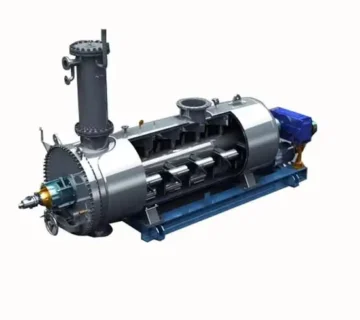Manufacturer: Niroo Bokhar Aras
The efficient processing of livestock and poultry by-products plays a significant role in reducing environmental waste and creating value-added products. Rendering cookers are essential in this process, helping industries convert waste into usable materials like animal feed, fertilizers, and biofuels. In this article, we explore the various types of rendering cookers available, their features, and tips for selecting the most suitable one for your needs.
Definition and Basics
Rendering cookers are industrial machines designed to process animal by-products, such as bones, fat, and feathers, into reusable materials. These cookers work by applying heat and pressure, breaking down organic matter and sterilizing it to produce safe and sustainable outputs.

Types of Rendering Cookers and Their Features
- Batch Rendering Cookers
- Application: Suitable for small-scale operations.
- Advantages: High precision, easy to operate, and cost-effective.
- Disadvantages: Slower processing time compared to continuous systems.
- Continuous Rendering Cookers
- Application: Designed for large-scale operations.
- Advantages: High efficiency, consistent output, and lower energy consumption per unit.
- Disadvantages: Requires significant upfront investment.
- High-Temperature Cookers
- Features: Operates at elevated temperatures for faster processing.
- Suitability: Effective for sterilization and odor control.
- Low-Temperature Cookers
- Features: Maintains nutrients in the output.
- Suitability: Ideal for producing high-quality animal feed.
Factors Influencing Price and Quality
- Material of Construction: Stainless steel cookers offer durability and resistance to corrosion.
- Capacity: Larger capacities often come with higher costs but increase efficiency.
- Energy Efficiency: Opting for energy-saving models can lower operational costs in the long run.
- Regulatory Compliance: Ensure the cooker meets standards like CE or DIN for guaranteed safety and performance.

Advantages and Disadvantages
Advantages
- Reduces environmental impact by minimizing waste.
- Produces marketable by-products like fats and protein meals.
- Contributes to biosecurity by sterilizing pathogens.
Disadvantages
- High initial investment.
- Requires skilled personnel for maintenance.
Buying Guide: Key Considerations
- Assess the volume of waste your facility generates.
- Determine whether a batch or continuous system fits your operational scale.
- Check for certifications ensuring quality and environmental safety.
- Consider after-sales support and warranties offered by manufacturers.

FAQs
- What is the primary use of rendering cookers?
Rendering cookers process animal waste into usable by-products. - What are the environmental benefits of using these cookers?
They reduce landfill waste and produce sustainable outputs. - Can rendering cookers handle all types of animal waste?
Yes, most modern systems are versatile. - What is the average lifespan of a rendering cooker?
With proper maintenance, it can last over 10 years. - How do I maintain a rendering cooker?
Regular cleaning, lubrication, and timely part replacements are crucial. - Are these machines energy-intensive?
Energy-efficient models are available, reducing overall power consumption. - What safety measures should be considered?
Ensure compliance with industry standards and proper training for operators. - Can these machines process poultry waste?
Yes, they are designed to handle all livestock and poultry by-products. - What output can be expected from these machines?
Outputs include tallow, protein meals, and fertilizers. - Why choose Niroo Bokhar Aras products?
Our machines are CE and DIN-certified, offering reliability and efficiency.
Conclusion
Rendering cookers are indispensable for industries aiming to manage waste sustainably while creating valuable products. With the right choice of machine, you can enhance your operation’s efficiency and minimize its environmental impact. For tailored solutions and pricing details, contact the sales team at Niroo Bokhar Aras today.


